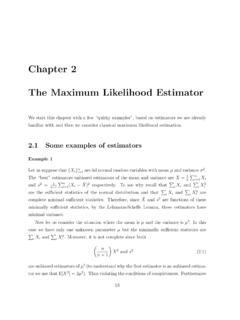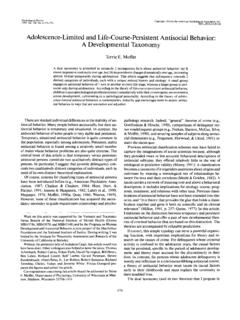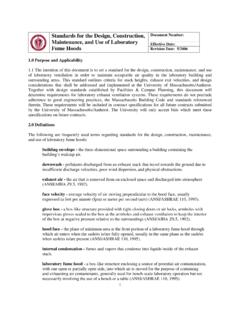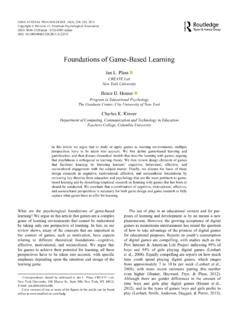Transcription of Overall Assessment of the Speaker’s Experience of ...
1 Journal of Fluency Disorders 31 (2006) 90 115 Overall Assessment of the Speaker s Experience ofStuttering (OASES): Documenting multipleoutcomes in stuttering treatmentJ. Scott Yarussa, , Robert W. QuesalbaStuttering Center of Western Pennsylvania, University of Pittsburgh, PA, United StatesbWestern Illinois University, Macomb, IL, United StatesReceived 18 May 2005; received in revised form 8 February 2006; accepted 14 February 2006 AbstractThis paper describes a new instrument for evaluating the Experience of the stuttering disorder fromthe perspective of individuals who stutter. Based on the World Health Organization sInternationalClassification of Functioning,Disability,and Health[World Health Organization (2001).]
2 The Inter-national Classification of Functioning,Disability,& Health. Geneva: World Health Organization], theOverall Assessment of the Speaker s Experience of Stuttering(OASES) collects information about thetotality of the stuttering disorder, including: (a) general perspectives about stuttering, (b) affective,behavioral, and cognitive reactions to stuttering, (c) functional communication difficulties, and (d)impact of stuttering on the speaker s quality of life. This paper summarizes scale development, reliabilityand validity Assessment , and scoring procedures so clinicians and researchers can use the OASES toadd to the available evidence about the outcomes of a variety of treatment approaches for adults objectives:As a result of this activity, participants will be able to:(1) identify key issues related to the documentation of treatment outcomes in stuttering;(2) discuss the components of theinternational classification of functioning,disability,and healthas theyrelate to the documentation of stuttering treatment outcomes.
3 Corresponding author. Tel.: +1 412 383 6538; fax: +1 412 383 Yaruss).0094-730X/$ see front matter 2006 Elsevier Inc. All rights Yaruss, Quesal / Journal of Fluency Disorders 31 (2006) 90 11591(3) evaluate and use a new measurement instrument for assessing the outcomes of stuttering treatment fromthe perspective of the person who stutters. 2006 Elsevier Inc. All rights :Treatment efficacy; Evaluation; ICIDH; ICF; Fluency disordersIn recent years, there has been a growing discussion about the importance of evidence-basedpractice (EBP) in the field of speech language pathology ( ,ASHA, 2005).
4 Although thechanges associated with implementing EBP affect many aspects of the field, the need for clini-cians to document the results of their intervention and to select treatment approaches based on ameaningful body of literature has been particularly apparent in the field of fluency disorders ( ,Blood, 1993;Blood & Conture, 1998;Bothe, 2003, 2004; Conture, 1996;Conture & Guitar, 1993;Cordes & Ingham, 1998;Finn, 2003; Ingham, 2003;Ingham & Riley, 1998;Langevin & Kully,2003;Onslow, 2003; Power, 2002;St. Louis & Westbrook, 1987;Starkweather, 1993;Thomas &Howell, 2001;Yaruss, 1998a, 1998b, 2001, 2004;Yaruss & Quesal, 2004a, 2004b).
5 One of the central tenets of an evidence-based approach to clinical practice is the measure-ment and evaluation of treatment outcomes (Frattali, 1998a; Olswang, 1998;Sackett, Straus,Richardson, Rosenberg, & Haynes, 2000). In fluency disorders, this has been addressed throughnumerous studies that have documented the effects of treatment on factors such as clinician-rated frequency of disfluencies, naturalness of speech, and speaking rate ( ,Ingham, 1984;Ingham & Onslow, 1985;Onslow, Costa, Andrews, & Harrison, 1996;Schiavetti & Metz, 1997).Results from these studies have clearly demonstrated that treatment can effectively minimizethese observable symptoms of the , as many authors have noted, there is more to the stuttering disorder than just the surfacefeatures ( ,Cooper, 1993; Manning, 1999, 2001; Murphy, 1999; Shapiro, 1999; Sheehan, 1970;Starkweather & Givens-Ackerman, 1998;Van Riper, 1982;Yaruss, 1998a;Yaruss & Quesal,2004a).
6 Perhaps the most well-known account isSheehan s (1970) iceberg analogy, whichdepicted the fact that much of the speaker s Experience of the stuttering disorder occurs underthe surface. Manning (1999)described the many ways in which stuttering can affect an individ-ual s life, while highlighting the fact that many of the changes associated with treatment occur notonly under the surface but also over time. Similarly,Murphy (1999)emphasized the strongemotions, such as shame and guilt that develop in many people who stutter. In addition, numer-ous autobiographical accounts (Bobrick, 1995; Carlisle, 1985; Jezer, 2003; Johnson, 1930) andcollected life stories of people who stutter ( ,Ahlbach & Benson, 1994; hood , 1998; St.)
7 Louis,2001) have underscored the fact that the Overall impact of stuttering on people s lives involvesmore than just the production of observable speech disfluencies. Indeed, even authors who havefocused their research primarily on the observable characteristics of stuttering have acknowledgedthe importance of considering a speaker s self-reports and perceptions about the disorder (Ingham& Cordes, 1997).1. The need for broad-based treatment outcomes research in stutteringAlthough many authors have shown that stuttering involves more than the behaviors that canbe observed on the surface, there areveryfew studies demonstrating the effects of Yaruss, Quesal / Journal of Fluency Disorders 31 (2006) 90 115on these intrinsic (Manning, 2001) factors (see reviews inBloodstein, 1995; Cordes, 1998).
8 The paucity of treatment outcomes research examining the totality of the stuttering disordermakes it difficult for clinicians to apply a strictly evidence-based approach to selecting treatmentoptions (Quesal, Yaruss, & Molt, 2004;Yaruss & Quesal, 2002), for much of the treatmentthat has been recommended by authorities over the years has not been subjected to empiricalresearch (Cordes, 1998). Thus, there is a compelling and immediate need for research on theoutcomes of treatment that address aspects of the stuttering disorder beyond the surface are a number of potential explanations for the relative lack of treatment outcomesstudies examining the less-observable components of stuttering.
9 One possible explanation is thefact that it is more difficult to define and measure the intrinsic aspects of a speaker s Experience ofstuttering ( , the speaker s beliefs and feelings about stuttering, the impact of stuttering on thespeaker s life) than it is to measure changes in speech behavior ( , the number of repetitionsor prolongations in a person s speech). Nevertheless, several instruments for measuring broaderaspects of the stuttering disorderdoexist ( ,Ammons & Johnson, 1944;Andrews & Cutler,1974;Brutten & Shoemaker, 1974;Crowe, Di Lollo, & Crowe, 2000;Erickson, 1969,Lanyon,1967;Ornstein & Manning, 1985;Riley, Riley, & Maguire, 2004;Watson, 1988; Woolf, 1967;Wright & Ayre, 2000).
10 These instruments examine a wide range of factors, including the speaker sfluency in different speaking situations, the speaker s confidence that he or she will be able tomaintain fluency in different situations, the emotional and cognitive reactions that speakers haveto stuttering in different speaking situations, the speaker s opinions or attitudes about stuttering,and other factors. Together, these instruments can give clinicians and researchers a more completepicture of the speaker s Experience of the stuttering disorder, and the application of such tools inthe study of stuttering treatment outcomes could help to provide needed information about thechanges people Experience as a result of a few notable exceptions ( ,Boberg & Kully, 1994), however, such instruments havenot been widely used in stuttering treatment outcomes research.
















